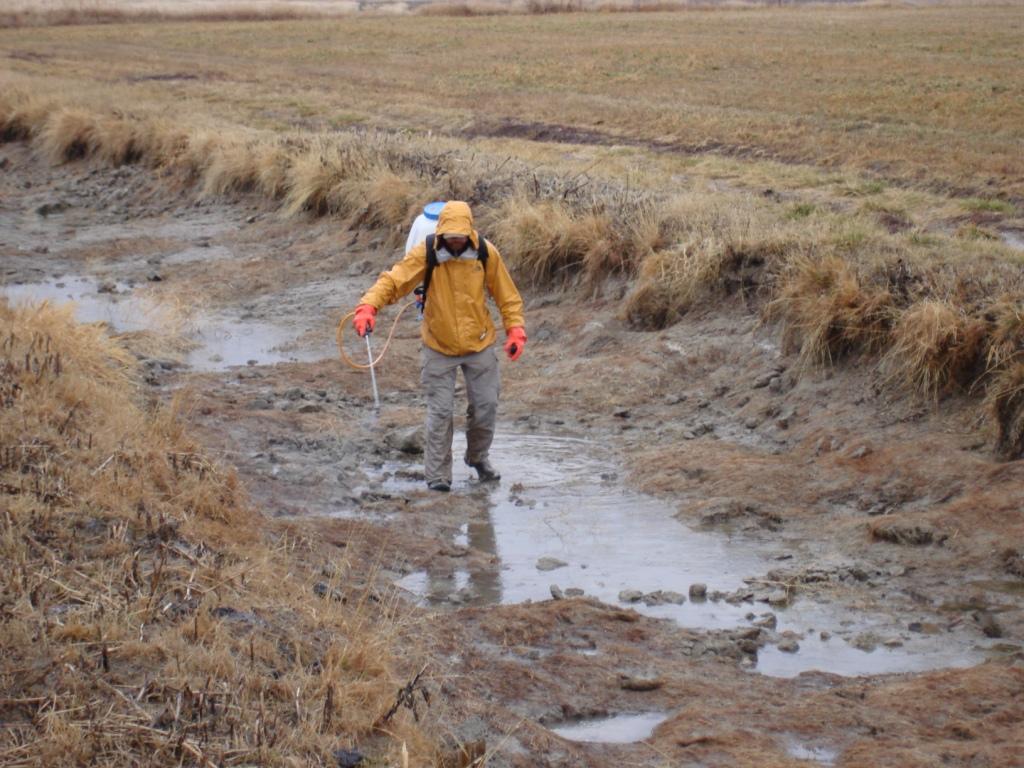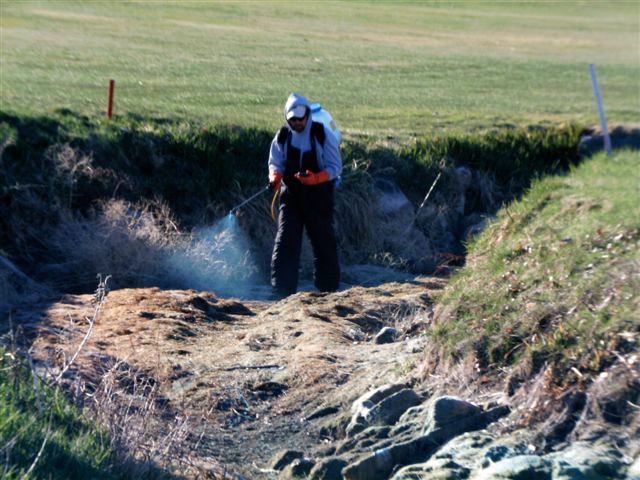Winter Drawdown: Reducing Nuisance Aquatic Weeds
October 14th, 2014
By Industry Expert Kyle Finerfrock, Environmental Scientist
 Sometimes, in order to solve a persistent problem, you have to take a different approach to gain the results you are looking for. A lake or pond choked out with aquatic weeds can be an issue for the people living around or using the waterbody. The typical method for treating this problem is to first identify the nuisance weed, second determine a treatment protocol, and then finally wait to see how the treatment works. If the results come out how you planned, then it’s a success. But when traditional methods do not work, the pressure is on to determine why the initial treatment failed and to quickly determine a better treatment procedure. Sometimes, traditional methods for treating aquatic weeds will not work because circumstances prevent you from treating how you would like. For example, some ponds are used for irrigation which restricts certain products from being used. In other ponds, the water chemistry can decrease the effectiveness of a product. These are some of the issues that have to be considered at every pond.So the challenge is set; traditional methods to treat during the growing season are not an option. As lake management professionals, it is our job to find a way to solve the problem. We have to think outside the “pond” to come up with a solution. Typically, most invasive aquatic plants originate from much warmer climates, but can survive over our cold winters because the pond insulates the plants from sub-freezing temperatures at the bottom. As temperatures drop, aquatic weeds go dormant to survive in the sediment over the cold winter months.
Sometimes, in order to solve a persistent problem, you have to take a different approach to gain the results you are looking for. A lake or pond choked out with aquatic weeds can be an issue for the people living around or using the waterbody. The typical method for treating this problem is to first identify the nuisance weed, second determine a treatment protocol, and then finally wait to see how the treatment works. If the results come out how you planned, then it’s a success. But when traditional methods do not work, the pressure is on to determine why the initial treatment failed and to quickly determine a better treatment procedure. Sometimes, traditional methods for treating aquatic weeds will not work because circumstances prevent you from treating how you would like. For example, some ponds are used for irrigation which restricts certain products from being used. In other ponds, the water chemistry can decrease the effectiveness of a product. These are some of the issues that have to be considered at every pond.So the challenge is set; traditional methods to treat during the growing season are not an option. As lake management professionals, it is our job to find a way to solve the problem. We have to think outside the “pond” to come up with a solution. Typically, most invasive aquatic plants originate from much warmer climates, but can survive over our cold winters because the pond insulates the plants from sub-freezing temperatures at the bottom. As temperatures drop, aquatic weeds go dormant to survive in the sediment over the cold winter months.
 An effective method, that is not new to lake management, is winter drawdown. This technique drops the water level to expose the dormant plants in the sediment to sub-freezing temperatures during winter months decreasing their survival. Additionally, “a drawdown is a prime opportunity to conduct a pre-emergent herbicide application for aquatic weed control,” says Sarah Miller, Aquatics Specialist at SePRO Corporation. “During this time, low rates can be strategically applied to the exposed littoral zone and prevent nuisance weeds from ever having a chance to establish or regrow after filling. This proactive approach provides a proven management option for sites with challenges such as high flow and irrigation use.” These products may not be an option during the summer, because of irrigation restrictions, but with no irrigation required in the winter, these products will be long gone before irrigation resumes in the spring.
An effective method, that is not new to lake management, is winter drawdown. This technique drops the water level to expose the dormant plants in the sediment to sub-freezing temperatures during winter months decreasing their survival. Additionally, “a drawdown is a prime opportunity to conduct a pre-emergent herbicide application for aquatic weed control,” says Sarah Miller, Aquatics Specialist at SePRO Corporation. “During this time, low rates can be strategically applied to the exposed littoral zone and prevent nuisance weeds from ever having a chance to establish or regrow after filling. This proactive approach provides a proven management option for sites with challenges such as high flow and irrigation use.” These products may not be an option during the summer, because of irrigation restrictions, but with no irrigation required in the winter, these products will be long gone before irrigation resumes in the spring.
This method does have some drawbacks and may not work in every lake or pond. In order to drawdown a waterbody, you must consider the wildlife living in the pond. Can the animals that make this pond home still survive the winter if the water level is dropped a few feet? Also, can the watershed downstream handle the excess flow of water leaving the pond? While these drawbacks can prevent you from using this method, the idea is to consider a different solution to your problem. With winter drawdown, we try to harness the power of nature to control a nuisance aquatic weed where traditional treatment methods are not an option.
Free Report: Nutrient Management Strategies
Contact the experts at 888-480-5253 for all of your lake, pond and fisheries management needs.
Kyle Finerfrock is an Environmental Scientist with SOLitude Lake Management. Since 1998, SOLitude Lake Management has been committed to providing full-service lake and pond management services that improve water quality, preserve natural resources, and reduce our environmental footprint. Services are available throughout the Eastern United States. Fisheries management consulting and aquatic products are available nationwide. Learn more about SOLitude Lake Management and purchase products at www.solitudelakemanagement.com.










